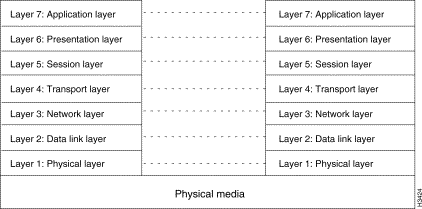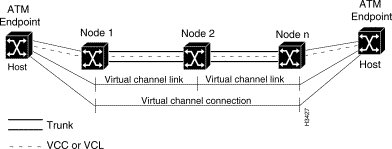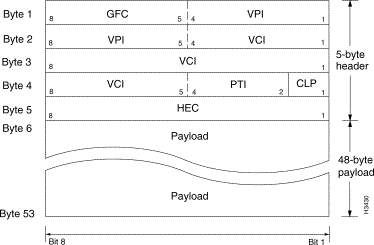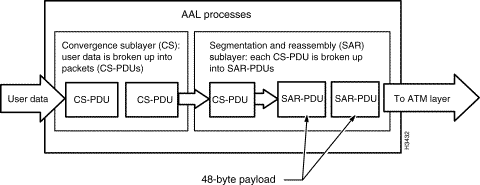|
|

This chapter describes the Asynchronous Transfer Mode (ATM) technology on which the LightStream 2020 multiservice ATM switch (LS2020 switch) is based. If you are already familiar with ATM, you can skip this chapter.
ATM is a communications standard based on cell relay techniques. The next sections discuss cell relay and ATM technology. They also contrast ATM techniques with time-division multiplexing (TDM) and other packet-handling technologies.
Cell relay is a flexible and responsive method for multiplexing all forms of digital traffic (data, voice, image, and video). Cell relay can handle rapid changes in the quantity and pattern of the traffic in the network. All traffic is placed in fixed-length packets of information (cells) and switched at high speeds. Cell relay is generally acknowledged as the best multiplexing technology for modern communication applications because it combines the strengths of TDM and conventional packet switching. Using cell relay packet-handling techniques, a mixture of bursty and delay-sensitive traffic can be processed simultaneously, while at the same time providing the services required by each traffic type.
Also, because cell relay processing is based on the use of small packets, the process technology is adaptable and cost effective for a wide range of interface speeds.
ATM technology first appeared in the Broadband Integrated Services Digital Network (BISDN). However, ATM is now recognized as a useful technology in and of itself and is based on the specifications and standards being developed by ITU-T (International Telecommunications Union Telecommunication Standardization Sector), ANSI (American National Standards Institute), and the ATM Forum.
Each ATM cell contains a header and the data to be transferred. Cells are switched in the network based on routing information contained in the cell headers. ATM transports all types of traffic (data, voice, image, and video) using the same cell format.
ATM contrasts with TDM in the way it allocates communications channels. In TDM, communications channels are divided into fixed periods of time called frames. The frames are divided into a fixed number of time slots of equal duration (see Figure 1-1). Each user is assigned certain time slots within each frame. As Figure 1-1 indicates, a user can be given more than one time slot in a frame.

The time slots allocated for each user occur at precisely the same time in every frame. Since the time slots are synchronous, TDM is sometimes referred to as Synchronous Transfer Mode (STM).
Users can access the communications channel only when a time slot that has been allocated to them is available. For example, User A can send messages over the communications channel only during the time slot(s) designated for User A. If no traffic is ready to send when the designated time slot occurs, that time slot is unused. If a user has a burst of traffic that exceeds the capacity of the designated time slots, additional slots cannot be used, even if they are idle. As a result, a long delay could result before the burst of traffic is transferred over the TDM network.
In ATM, access to the communications channel is more flexible. Any user needing the communications channel can use it whenever it is available. In contrast to TDM, ATM imposes no regular pattern on the way users are given access to the communications channel. ATM is also described as providing bandwidth on demand.
In other packet-handling technologies, such as High-Level Data Link Control (HDLC), any user can gain access to the communications channel, but a user who has a long message to send can prevent other users from gaining access to the channel until the entire message has been passed. However, with ATM, every message is divided into small, fixed-length cells. Thus, no single user can monopolize access to the communications channel while other users have messages to send (see Figure 1-2).

ATM technology offers four principal benefits:
ATM standards define protocols that operate at Layer 2 (the data link layer) of the International Standards Organization (ISO) seven-layer Open Systems Interconnection (OSI) reference model. Figure 1-3 shows the layered architecture of the OSI model.

The data link layer is concerned with data transmission between two network switches. This layer is not concerned with the transmission of an entire message between a source and a destination switch--this responsibility belongs to Layer 3 (the network layer). Rather, the data link layer transports portions of messages (cells, in the case of ATM) between two points in the network. These points may be the source and the destination of the message, or they may be only intermediate hops between the source and the destination.
The data link layer may divide higher level data into smaller units (cells, in this case), whose sizes are compatible with overall network requirements. Layer 2 data units contain a cell header, an information field, and some method of checking for transmission errors.
Before frames can be transported across an ATM network, they must be divided into ATM cells. The processes that divide the frames into cells occur at the data link layer (Layer 2). Layer 2 is divided into two parts: the ATM adaptation layer (AAL) and the ATM layer. Once frames are divided into ATM cells, the cells can be transferred to Layer 1, the physical layer (see Figure 1-4).

ATM uses label switching, a technique in which a simple label is placed in the header of each cell. The label provides information used in transporting the cell across the next hop in the network. Networks that do not use label switching usually require each packet (or cell) to contain the explicit address of the final destination. ATM uses label switching because it is simpler, thereby making faster switching possible.
Here is how label switching works:
For example, suppose that your network includes a switching unit called Boston. A number of data paths go through the Boston switch. When those data paths are created, a routing table is set up within the Boston switch. The table in the Boston switch has one entry for every data path that goes through the switch. The entries in the table map the incoming port and label to an outgoing port and label for each data path, as shown in Table 1-1.
| Port In | Label In | Port Out | Label Out |
| 1 | L | 6 | Z |
| 1 | M | 7 | X |
| 2 | N | 7 | Y |
When the Boston switch receives an incoming cell on port 1 with label M, it consults the routing table and finds that label M should be replaced with label X, and that the cell should be passed out of the Boston switch on port 7. The cell is then transported to the switch in the network that is connected to port 7 of the Boston switch, as shown in Figure 1-5.

In all cases, transporting cells through the use of label switching requires a connection. Information about the connections is provided in the routing tables (sometimes called lookup tables) of switching and multiplexing units. ATM uses virtual channel connections and virtual paths to accomplish routing functions.
A virtual channel connection (VCC) is a series of virtual channel links (VCLs) between two ATM points. A VCL is a means of bidirectional transport of ATM cells between a point where a virtual channel identifier (VCI) value is assigned and the point where the same value is either reassigned or terminated. The VCI identifies the VCL to which a cell belongs and determines where the cell should go next. Figure 1-6 shows the relationship between VCLs and VCCs in an ATM network.

VCCs are sometimes transported within virtual paths (VPs). A VP is identified by its virtual path identifier (VPI). VPs provide a convenient way of bundling traffic directed to the same destination or traffic requiring the same Quality of Service (QoS) in the network (see Figure 1-7).

The ATM cell is the fixed-length transmission unit defined by the ATM standard. An ATM cell contains two major types of information: the payload and the header. The payload is the information to be transferred through an ATM network. It can include data, voice, image, or video. The header is the information used to route the cell through the network and to ensure that the cell is forwarded to its destination.
Every ATM cell is 53 bytes long. The first 5 bytes contain header information, and the remaining 48 bytes contain the payload (see Figure 1-8).

The 5-byte header (see Figure 1-9) contains several different fields (seeTable 1-2). The 48 bytes following the header (the payload) contain user data.

The AAL accepts frames from higher OSI layers and adapts them to the 48-byte segments that are placed into the payload field of ATM cells. The ATM layer accepts the 48-byte segments, adds the 5-byte header, and produces ATM cells to be transferred to the physical layer, as illustrated in Figure 1-10.

When ATM cells are transferred through a network, each cell is processed in isolation from all other cells. All processing decisions are made based on the cell header; no processing of the data in the payload field occurs.
Figure 1-11 presents some examples of AAL processing.

Hosts A and C are connected to the network through ATM interfaces, so they do all their AAL processing internally. The network does not do any processing for hosts A and C. Hosts B and D are connected to native Ethernet interfaces on Nodes 1 and 2. Therefore, Node 2 does all the AAL processing for Host D. Node 3 does no AAL processing.
Depending on the type of traffic entering the ATM network, the AAL uses one of four different AAL types to divide the traffic into small segments. These types are classified according to the timing relationship between the source and destination, the constant or variable bit rate, and the mode (connection-oriented or connectionless). The AAL types defined in the ATM standard are listed in Table 1-3.
The AAL is divided into two sublayers: the convergence sublayer (CS) and the segmentation and reassembly sublayer (SAR), (see Figure 1-12).

The convergence sublayer (CS) accepts higher layer traffic for transmission across the network. Depending on the AAL type, header and/or trailer fields are added to the packet. The packet is then segmented by the SAR sublayer to form 48-byte payloads (also known collectively as SAR-PDUs).
Upon receipt of cell payloads, the AAL removes any AAL-specific information from each payload and reassembles the entire packet before passing it to a higher layer (see Figure 1-13).

The ATM layer accepts the 48-byte SAR-PDUs from the SAR process, adds a 5-byte header to each, and produces ATM cells for transfer to the physical layer (see Figure 1-14).

Once the data is packaged into 53-byte ATM cells, the cells are transferred to the physical layer, where they are placed onto a physical transport medium, such as fiber optic cable or coaxial cable. The process of placing cells onto the physical medium takes place in two sublayers: the physical medium dependent (PMD) sublayer and the transmission convergence (TC) sublayer.
Each PMD is specific to a particular physical medium and includes definitions of proper cabling as well as bit timing. The TC sublayer generates and receives transmission frames and performs all overhead functions associated with the transmission frame. The TC sublayer performs a convergence function by receiving a bit stream from the PMD and extracting cells.
Although PMD operation depends on the physical medium, the following TC functions remain common to all physical layers:
|
|